Service hotline
+86 0755-83044319
release time:2025-05-29Author source:SlkorBrowse:6488
Driven by the wave of smart homes, the Chinese smart door lock market is witnessing explosive growth, both in volume and value. Data from the first quarter of 2025 shows that the market size of smart door locks has grown by more than 20% compared to the previous year, with mid-to-high-end products priced above 2,000 yuan seeing an even greater increase of over 80%. Behind this trend is the deep integration of technologies like biometric recognition, the Internet of Things (IoT), and artificial intelligence, transforming smart door locks from traditional mechanical locks into intelligent security devices that combine fingerprint recognition, 3D facial unlocking, and remote control.
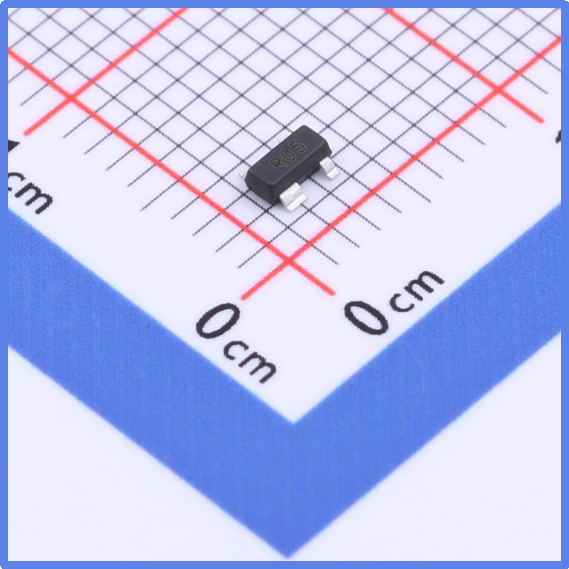
Slkor Electrostatic Discharge Diode SLSR05LC product photo
The technological upgrades not only bring innovation in functionality but also pose stringent challenges to product reliability. The control board of smart door locks integrates precise components such as lithium battery power systems, millimeter-wave radar sensors, Bluetooth communication modules, and fingerprint recognition chips. These high-frequency, high-speed interfaces are vulnerable to electrostatic discharge (ESD) in complex electromagnetic environments. Experimental data shows that human body electrostatic discharge can reach several thousand volts in dry environments, far exceeding the tolerance threshold of integrated circuits. This can lead to system crashes or, in severe cases, permanent damage to the chips.
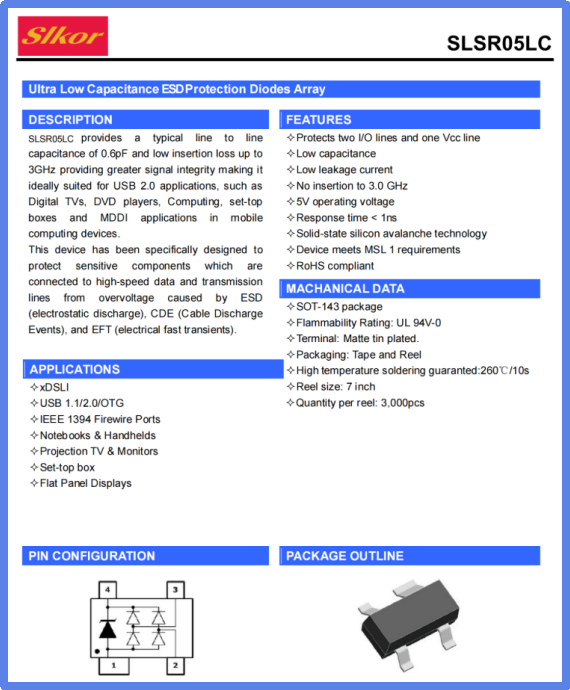
Slkor Electrostatic Discharge Diode SLSR05LC specification

Parameters of Slkor Electrostatic Discharge Diode SLSR05LC
Designed specifically for high-speed interfaces, the SLSR05LC has become a core component in ESD protection solutions for smart door locks due to its unique electrical characteristics. The device uses a small SOT-143 package and has a working voltage (VRWM) of 5V, perfectly matching the power supply needs of mainstream digital circuits in smart door locks. Its minimum breakdown voltage (VBR min) of 6V and clamping voltage (VC) of 15.5V form a precise protection window, effectively dissipating ESD energy and preventing signal distortion caused by false triggering.
The core advantages of the device can be seen in three dimensions: First, the ultra-low junction capacitance design, with a parasitic capacitance of 0.6pF, ensures signal integrity, especially in high-speed data transmission scenarios such as USB 2.0 and MIPI interfaces. Second, its nanosecond response time allows the creation of a low-resistance path during the rise phase of the ESD pulse, limiting the overvoltage to safe levels. Finally, its excellent surge handling capability, with a peak pulse power of 350W (8/20μs waveform), meets the IEC 61000-4-5 standard for 3A (8/20μs) lightning surge.
In the system architecture of smart door locks, the SLSR05LC is deployed at multiple electrostatic-sensitive nodes:
- Type-C Interface Protection: For the USB power and data transmission combined interface, the SLSR05LC, in conjunction with a power inductor, forms an LC filter network that creates a bidirectional protection barrier on the 5V power rail. Testing shows that this solution can limit ESD impacts of ±8kV contact discharge and ±15kV air discharge to the chip's safe operating area (SOA).
- Biometric Module Protection: The SLSR05LC is connected in parallel on the I2C bus between the fingerprint sensor and the MCU, ensuring that its 0.6pF ultra-low capacitance does not affect the signal edge rate. Experimental data shows that under a 1GHz frequency band, signal attenuation is less than 0.5dB, fully meeting the high-speed sampling requirements of capacitive sensors.
- Wireless Communication Module Protection: For the Bluetooth/Wi-Fi antenna’s RF traces, the SLSR05LC works in tandem with a π-type filter to achieve -3dB insertion loss in the 2.4GHz/5GHz frequency bands while raising the ESD protection level to the IEC 61000-4-2 standard level 4.
- Human-Machine Interface Protection: For each signal line of the touch buttons, an independent SLSR05LC is configured, ensuring a super-low leakage current (IR) of 1μA, keeping standby power consumption below 10μA, in line with the design requirements for ultra-long battery life in smart door locks.
Data from a leading smart door lock manufacturer shows that after adopting the SLSR05LC protection solution, the product's ESD failure rate dropped from 0.32% to 0.05%, and after-sales maintenance costs decreased by 65%. In wide-temperature testing from -40°C to 85°C, the device's parameter drift was less than 3%, demonstrating outstanding environmental adaptability. More notably, the device's surge protection design reduced the failure rate of smart door locks during thunderstorms by 82%.
As smart door locks evolve towards new technologies like vein recognition and AI vision, higher requirements are being placed on ESD protection devices. The future upgrade direction for the SLSR05LC focuses on three areas: first, developing models for 5G communications with even lower junction capacitance (<0.3pF); second, introducing integrated protection modules that support Power over Ethernet (PoE); and third, researching adaptive protection circuits based on AI algorithms. These technological breakthroughs will further solidify the security foundation of smart door locks in the smart home ecosystem.
In the era of the Internet of Things, basic components like the SLSR05LC are acting as "invisible guardians" to ensure the reliability of smart terminals. Its technological evolution trajectory validates an industry trend: true innovation lies not only in visible functional upgrades but also in the unseen protective details. With the further implementation of the "Cybersecurity Technology Smart Door Lock Network Security Technical Specifications," high-performance protection devices like the SLSR05LC will usher in broader application prospects, continuously driving the smart home industry towards high-quality development.
Slkor has research and development offices in Busan, South Korea, Beijing, China, and Suzhou, China. Most of the wafer manufacturing and packaging and testing are carried out within China. The company employs and collaborates with individuals and organizations worldwide, with a laboratory for product performance and reliability testing and a central warehouse located at its headquarters in Shenzhen. Slkor has filed for over a hundred invention patents, offers more than 2,000 product models, and serves over ten thousand customers globally. Its products are exported to countries and regions including Europe, the Americas, Southeast Asia, and the Middle East, making it one of the rapidly growing semiconductor companies in recent years. With well-established management systems and streamlined workflows, Slkor has rapidly enhanced the brand awareness and reputation of its "SLKOR" brand through its outstanding quality and standardized services. Its product range includes three major series: diodes, transistors, and power devices, with recent introductions of new products such as Hall elements and analog devices, expanding its presence in sensors, Risc-v microcontrollers, and other product categories.

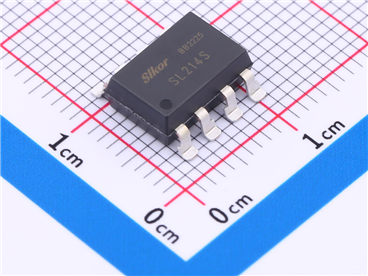
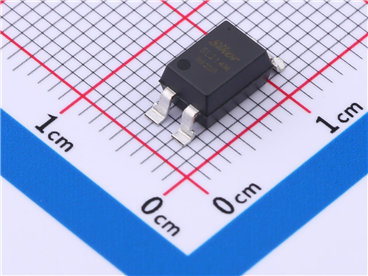
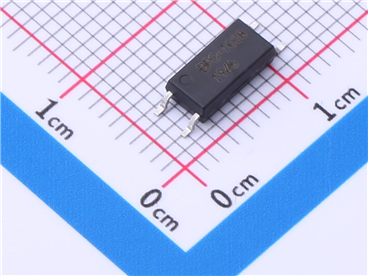
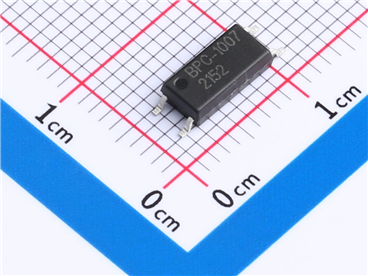




Site Map | 萨科微 | 金航标 | Slkor | Kinghelm
RU | FR | DE | IT | ES | PT | JA | KO | AR | TR | TH | MS | VI | MG | FA | ZH-TW | HR | BG | SD| GD | SN | SM | PS | LB | KY | KU | HAW | CO | AM | UZ | TG | SU | ST | ML | KK | NY | ZU | YO | TE | TA | SO| PA| NE | MN | MI | LA | LO | KM | KN
| JW | IG | HMN | HA | EO | CEB | BS | BN | UR | HT | KA | EU | AZ | HY | YI |MK | IS | BE | CY | GA | SW | SV | AF | FA | TR | TH | MT | HU | GL | ET | NL | DA | CS | FI | EL | HI | NO | PL | RO | CA | TL | IW | LV | ID | LT | SR | SQ | SL | UK
Copyright ©2015-2025 Shenzhen Slkor Micro Semicon Co., Ltd